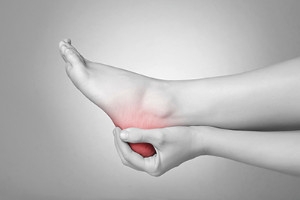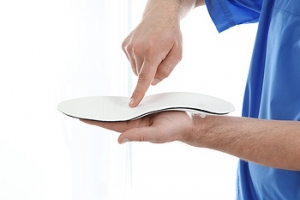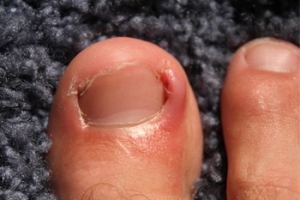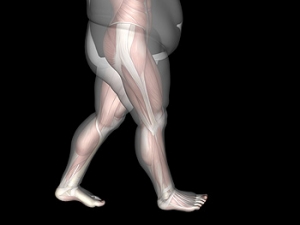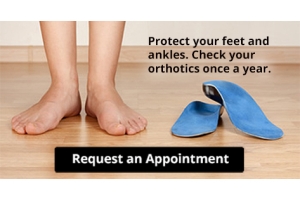283 St Rose Ave
Windsor, ON N8S 1X1

Is My Child Affected by Sever’s Disease?
 Children who participate in running and jumping activities may be susceptible to developing Sever’s disease. This condition can target young adolescents, and affects the growth plate in the heel. It can occur as a result of increased running activities, or during a growth spurt. Common symptoms that are associated with Sever’s disease can consist of pain and discomfort in the heel and surrounding area, and the Achilles tendon may become tight, possibly causing difficulty in walking. Research has indicated it may help to cease the activity that caused this condition, in addition to performing specific stretching exercises which may be beneficial in strengthening the affected foot. If your active child is exhibiting heel pain, it is suggested that you consult with a podiatrist who can properly treat this condition.
Children who participate in running and jumping activities may be susceptible to developing Sever’s disease. This condition can target young adolescents, and affects the growth plate in the heel. It can occur as a result of increased running activities, or during a growth spurt. Common symptoms that are associated with Sever’s disease can consist of pain and discomfort in the heel and surrounding area, and the Achilles tendon may become tight, possibly causing difficulty in walking. Research has indicated it may help to cease the activity that caused this condition, in addition to performing specific stretching exercises which may be beneficial in strengthening the affected foot. If your active child is exhibiting heel pain, it is suggested that you consult with a podiatrist who can properly treat this condition.
Sever's disease often occurs in children and teens. If your child is experiencing foot or ankle pain, see the practitioners from Foot Care Institute. Our practitioners can treat your child’s foot and ankle needs.
Sever’s Disease
Sever’s disease is also known as calcaneal apophysitis, which is a medical condition that causes heel pain I none or both feet. The disease is known to affect children between the ages of 8 and 14.
Sever’s disease occurs when part of the child’s heel known as the growth plate (calcaneal epiphysis) is attached to the Achilles tendon. This area can suffer injury when the muscles and tendons of the growing foot do not keep pace with bone growth. Therefore, the constant pain which one experiences at the back of the heel will make the child unable to put any weight on the heel. The child is then forced to walk on their toes.
Symptoms
Acute pain – Pain associated with Sever’s disease is usually felt in the heel when the child engages in physical activity such as walking, jumping and or running.
Highly active – Children who are very active are among the most susceptible in experiencing Sever’s disease, because of the stress and tension placed on their feet.
If you have any questions, please feel free to contact our office located in Windsor, ON . We offer the newest diagnostic and treatment technologies for all your foot and ankle injuries.
Sever's Disease
Sever’s disease, also known as calcaneal apophysitis is a common bone disorder that occurs during childhood. The disease is defined as an inflammation of the growth plate in the heel. When a child has a growth spurt, his heel bone grows faster than the muscles, tendons, and ligaments in his leg. This disease is a result of overuse. The people who are most likely to be affected by this disease are children who are in a growth spurt, especially boys who are from the ages of 5 to 13 years old. 60% of children with Sever’s disease have both heels involved.
Symptoms of this disease are heel pain that intensifies during running and jumping activities. The pain is typically localized to the posterior part of the heel. Symptoms may be severe, and they can easily interfere with daily activities. Children who play soccer, baseball, and basketball are more likely to develop Sever’s disease.
Your doctor will diagnose your child based on his or her symptoms, x-rays are generally not helpful in diagnosing this disease. Your doctor may examine both heels and ask your child questions about his or her activity level in sports. Your doctor may then use the squeeze test on your child’s heel to see if there is any pain. Nevertheless, some doctors might still use x-rays to rule out any other issues such as fractures, infections, and tumors.
Sever’s disease can be prevented by maintaining good flexibility while your child is growing. Another prevention method is to wear good-quality shoes that have firm support and a shock-absorbent sole. Sever’s disease can be treated by ceasing any activity that causes heel pain. You should apply ice to the injured heel for 20 minutes 3 times a day. Additionally, orthotics should be used for children who have high arches, flat feet, or bowed legs.
If you suspect your child has Sever’s disease, you should make an appointment with your podiatrist to have his or her foot examined. Your doctor may recommend nonsteroidal anti-inflammatory drugs (NSAIDs), such as ibuprofen or naproxen to relieve pain. In more severe cases, your child may need a cast to rest his or her heel. Fortunately, Sever’s disease does not cause long-term foot problems. After treatment, your child should start to feel better within two weeks to two months.
How Are Orthotics Made?
 Orthotics are known as insoles that fit inside shoes, which may help to provide the necessary support needed for specific foot conditions. They are custom designed for each patient, and the process begins with taking a plaster mold of the affected foot. The necessary adjustments can be made for size, as this will help the insole to fit perfectly inside the shoe. Some of the reasons why patients choose to wear orthotics may consist of correcting an abnormal walking pattern, or to relieve pressure in a portion of the foot. Additionally, orthotics may help to reduce chronic foot pain, as well as improve certain foot alignments. If you would like more information about custom-made orthotics, please consult with a podiatrist who can determine if they are right for you.
Orthotics are known as insoles that fit inside shoes, which may help to provide the necessary support needed for specific foot conditions. They are custom designed for each patient, and the process begins with taking a plaster mold of the affected foot. The necessary adjustments can be made for size, as this will help the insole to fit perfectly inside the shoe. Some of the reasons why patients choose to wear orthotics may consist of correcting an abnormal walking pattern, or to relieve pressure in a portion of the foot. Additionally, orthotics may help to reduce chronic foot pain, as well as improve certain foot alignments. If you would like more information about custom-made orthotics, please consult with a podiatrist who can determine if they are right for you.
If you are having discomfort in your feet and would like to try orthotics, contact the practitioners from Foot Care Institute. Our practitioners can provide the care you need to keep you pain-free and on your feet.
What Are Orthotics?
Orthotics are inserts you can place into your shoes to help with a variety of foot problems such as flat feet or foot pain. Orthotics provide relief and comfort for minor foot and heel pain but can’t correct serious biomechanical problems in your feet.
Over-the-Counter Inserts
Orthotics come in a wide variety of over-the-counter inserts that are used to treat foot pain, heel pain, and minor problems. For example, arch supports can be inserted into your shoes to help correct overarched or flat feet, while gel insoles are often used because they provide comfort and relief from foot and heel pain by alleviating pressure.
Prescription Orthotics
If over-the-counter inserts don’t work for you or if you have a more severe foot concern, it is possible to have your podiatrist prescribe custom orthotics. These high-quality inserts are designed to treat problems such as abnormal motion, plantar fasciitis, and severe forms of heel pain. They can even be used to help patients suffering from diabetes by treating foot ulcers and painful calluses and are usually molded to your feet individually, which allows them to provide full support and comfort.
If you are experiencing minor to severe foot or heel pain, it’s recommended to speak with your podiatrist about the possibilities of using orthotics. A podiatrist can determine which type of orthotic is right for you and allow you to take the first steps towards being pain-free.
If you have any questions please contact our office located in Windsor, ON . We offer the newest diagnostic and treatment technologies for all your foot and ankle needs.
Foot Orthotics
Orthotics are shoe inserts that are meant to correct an irregular walking gait or provide cushioning to the feet. Orthotics come in a variety of different models and sizes, including over-the-counter and customizable variants. Customizable orthotics can be shaped and contoured to fit inside a specific shoe and are typically prescribed through a podiatrist who specializes in customized footwear and orthotics design and management.
Orthotics are beneficial because they can help prevent injuries from occurring and provide cushioning to keep pain levels down to a minimum. They also allow for the correct positioning of the feet. Orthotics can act as shock absorbers to help remove pressure from the foot and ankle. Therefore, orthotics can make bodily movements, such as walking and running, become more comfortable as well as help prevent the development of certain foot conditions.
Orthotics alleviate pain and make the foot more comfortable by slightly altering the angle at which the foot strikes the ground surface, therefore controlling the movement of the foot and ankle. Orthotics come in different variants and can be made of various materials. To determine what type of orthotic is most suited to your feet and your needs, it is best to consult your podiatrist. He or she will be able to recommend a type of orthotic that can help improve your foot function or prescribe a custom orthotic to best fit your feet.
Preventing Ingrown Toenails
 An ingrown toenail is a painful condition that consists of the nail growing into the flesh of the toe. This can be incredibly painful, and may also make it difficult for someone with this condition to go about their daily activities. If an ingrown toenail is left untreated, it may run the risk of developing an infection. If this occurs, the affected area might start to bleed or drain pus. To help prevent an ingrown toenail from forming, it is recommended that you trim your toenails properly. To best do this, it’s important that you cut your toenails straight across, instead of on an angle. It’s also advised not to trim your toenails too short, as doing so may also cause an ingrown toenail to develop. For more information on how to prevent and treat this condition, please consult with a podiatrist for professional care.
An ingrown toenail is a painful condition that consists of the nail growing into the flesh of the toe. This can be incredibly painful, and may also make it difficult for someone with this condition to go about their daily activities. If an ingrown toenail is left untreated, it may run the risk of developing an infection. If this occurs, the affected area might start to bleed or drain pus. To help prevent an ingrown toenail from forming, it is recommended that you trim your toenails properly. To best do this, it’s important that you cut your toenails straight across, instead of on an angle. It’s also advised not to trim your toenails too short, as doing so may also cause an ingrown toenail to develop. For more information on how to prevent and treat this condition, please consult with a podiatrist for professional care.
Ingrown toenails can become painful if they are not treated properly. For more information about ingrown toenails, contact the practitioners of Foot Care Institute. Our practitioners can provide the care you need to keep you pain-free and on your feet.
Ingrown Toenails
Ingrown toenails occur when a toenail grows sideways into the bed of the nail, causing pain, swelling, and possibly infection.
Causes
- Bacterial infections
- Improper nail cutting such as cutting it too short or not straight across
- Trauma to the toe, such as stubbing, which causes the nail to grow back irregularly
- Ill-fitting shoes that bunch the toes too close together
- Genetic predisposition
Prevention
Because ingrown toenails are not something found outside of shoe-wearing cultures, going barefoot as often as possible will decrease the likeliness of developing ingrown toenails. Wearing proper fitting shoes and using proper cutting techniques will also help decrease your risk of developing ingrown toenails.
Treatment
Ingrown toenails are a very treatable foot condition. In minor cases, soaking the affected area in salt or antibacterial soaps will not only help with the ingrown nail itself, but also help prevent any infections from occurring. In more severe cases, surgery is an option. In either case, speaking to your podiatrist about this condition will help you get a better understanding of specific treatment options that are right for you.
If you have any questions please feel free to contact our office located in Windsor, ON . We offer the newest diagnostic and treatment technologies for all your foot and ankle needs.
Ingrown Toenails
An ingrown toenail is a nail that has curved downward and grown into the skin. This typically occurs at either the nail borders or the sides of the nail. As a result, pain, redness, swelling, and warmth may occur in the toe. If a break in the skin forms due to the ingrown nail, bacteria may enter and cause an infection in the area; this is typically characterized by a foul odor and drainage.
Ingrown toenails have multiple reasons for developing. In many instances, the condition is a result of genetics and is inherited. The most common cause, however, is improper trimming; cutting the toenails too short forces the skin beside the nail to fold over. An ingrown toenail can also develop due to trauma, such as stubbing the toe, having an object fall on the toe, or participating in activities that involve repeated kicking or running. Wearing shoes that are too tight or too short can also cause ingrown toenails.
Treatment for an ingrown toenail varies between patients and the severity of the condition. In most cases, it is best to see your podiatrist for thorough and proper treatment. After examining your toe, your podiatrist may prescribe oral antibiotics to clear the infection if one is present. Surgical removal of either a portion of the nail or the entire nail may also be considered. In some cases, complete removal or destruction of the nail root may be required. Most patients who undergo nail surgery experience minimal pain afterward and can return to normal activity the following day.
Ingrown toenails can be prevented with proper nail trimming and by avoiding improper-fitting shoes. When cutting the toenails, be sure that you are cutting in a straight line and avoid cutting them too short. Shoes should not be too short or tight in the toe box.
Obesity May Cause Foot Conditions to Develop
 The feet and ankles endure increased pressure if one is overweight. This may cause foot conditions to develop that can include different types of arthritis, plantar fasciitis, and flat feet. Additionally, the skin on the feet may be affected, which may cause pain and discomfort. It may be difficult to maintain a good quality of life while there is general foot pain, and it is suggested that a healthy diet is implemented. This can include eating fresh fruits and vegetables, drinking plenty of water daily, and practicing a gentle exercise regime. If you would like more information about how obesity can affect the feet, please consult with a podiatrist.
The feet and ankles endure increased pressure if one is overweight. This may cause foot conditions to develop that can include different types of arthritis, plantar fasciitis, and flat feet. Additionally, the skin on the feet may be affected, which may cause pain and discomfort. It may be difficult to maintain a good quality of life while there is general foot pain, and it is suggested that a healthy diet is implemented. This can include eating fresh fruits and vegetables, drinking plenty of water daily, and practicing a gentle exercise regime. If you would like more information about how obesity can affect the feet, please consult with a podiatrist.
Obesity has become very problematic at this point in time and can have extremely negative effects on the feet. If you’re an obese individual and are concerned about your feet, contact the practitioners from Foot Care Institute. Our practitioners can provide the care you need to keep you pain-free and on your feet.
Obesity and Your Feet
Since your feet are what support your entire weight when standing, any additional weight can result in pain and swelling. Being overweight is one of the main contributors to foot complications.
Problems & Complications
Extra Weight – Even putting on just a few extra pounds could create serious complications for your feet. As your weight increases, your balance and body will shift, creating new stresses on your feet. This uneven weight distribution can cause pain, even while doing the simplest tasks, such as walking.
Diabetes – People who are overweight are at serious risk of developing type-2 diabetes, which has a drastic impact on the health of your feet. As you get older, your diabetes might worsen, which could lead to loss of feeling in your feet, sores, and bruises. You could also become more prone to various infections.
Plantar fasciitis – Pressure and stress that is placed on muscles, joints, and tendons can trigger plantar fasciitis, which is an inflammation of tissue that forms along the bottom of the foot.
If you have any questions please feel free to contact our office located in Windsor, ON . We offer the newest diagnostic and treatment technologies for all your foot and ankle needs.
How Obesity Affects Your Feet
Gaining weight can happen suddenly and at any time. Usually you won’t notice the extra weight until your feet start hurting at the end of the day. This happens as your feet begin adjusting to carrying more weight. Foot swelling and pain are two of the biggest side effects of having gained weight.
Many foot-related problems can occur even after just putting on a few pounds. This includes the body ‘compensating’ by changing the way it moves. You may find yourself putting extra weight on the wrong parts of your feet and even leaning forward a bit. Your feet were designed to carry a healthy, normal body weight. Extra weight places undue stress on them.
Being overweight often causes the development of Type-2 diabetes, causing leg and foot pain. Older people who do not attempt to control their condition can even lose sensation and feeling in their legs and feet. This can lead to the development of small sores that can lead to serious infection.
Extra stress placed on the joints, tendons and muscles in the feet as a result of extra body weight may also cause heel spurs, or plantar fasciitis. Plantar fasciitis is an inflammation of the foot tissue, causing stiffness and pain when walking and climbing stairs. This can usually be relieved by foot stretches and custom made orthotic shoe-inserts.
Problems in the feet triggered by obesity can be treated by paying special attention to footwear. Proper support shoes that allow for good circulation, especially in the arch and ankle, are vital. A podiatrist can help you find what sort of shoe is most suitable for your feet. They can also measure you for special orthotics if necessary.
It could also be high time to start losing weight in order to treat and prevent diabetes as well as other life threatening diseases. Some methods include yoga and water aerobics, which benefit your entire body without placing stress on your feet. Don’t risk losing your feet by losing interest in them. Take care of your feet and your body, as they deserve the very best.
How Does Arthritis Affect the Feet?
 One particular kind of arthritis that can affect the feet and ankles is known as rheumatoid arthritis, or RA. Symptoms of RA may include the feeling of stiffness in the ankle joints, which may stem from an inflammation issue of the ankles. Over time, the overall structure and shape of the joints in the ankle may change due to RA. Those with RA may feel pain in the heel, Achilles tendon region, toes, and ball of the foot. Patients with rheumatoid arthritis may also experience difficulty walking or standing for long periods of time, as the overall mobility of their joints become increasingly restricted. Partaking in light exercises, following an anti-inflammatory diet, and using medication for reducing inflammation and pain may help to relieve the symptoms of RA. For information on how arthritis affects the feet, we recommend you consult with a podiatrist for professional care and an advised treatment plan.
One particular kind of arthritis that can affect the feet and ankles is known as rheumatoid arthritis, or RA. Symptoms of RA may include the feeling of stiffness in the ankle joints, which may stem from an inflammation issue of the ankles. Over time, the overall structure and shape of the joints in the ankle may change due to RA. Those with RA may feel pain in the heel, Achilles tendon region, toes, and ball of the foot. Patients with rheumatoid arthritis may also experience difficulty walking or standing for long periods of time, as the overall mobility of their joints become increasingly restricted. Partaking in light exercises, following an anti-inflammatory diet, and using medication for reducing inflammation and pain may help to relieve the symptoms of RA. For information on how arthritis affects the feet, we recommend you consult with a podiatrist for professional care and an advised treatment plan.
Arthritis can be a difficult condition to live with. If you are seeking treatment, contact the practitioners from Foot Care Institute. Our practitioners can provide the care you need to keep you pain-free and on your feet.
Arthritic Foot Care
Arthritis is a joint disorder that involves the inflammation of different joints in your body, such as those in your feet. Arthritis is often caused by a degenerative joint disease and causes mild to severe pain in all affected areas. In addition to this, swelling and stiffness in the affected joints can also be a common symptom of arthritis.
In many cases, wearing ill-fitting shoes can worsen the effects and pain of arthritis. Wearing shoes that have a lower heel and extra room can help your feet feel more comfortable. In cases of rheumatoid arthritis, the arch in your foot may become problematic. Buying shoes with proper arch support that contour to your feet can help immensely.
Alleviating Arthritic Pain
- Exercises that stretch the foot can prevent further pain and injury and increase mobility
- Most of the pain can be alleviated with anti-inflammatory drugs, heat, and topical medications
- Massages can help temporarily alleviate pain.
It is best to see your doctor for the treatment that is right for your needs and symptoms. Conditions vary, and a podiatrist can help you determine the right method of care for your feet.
If you have any questions, please feel free to contact our office located in Windsor, ON . We offer the newest diagnostic tools and technology to treat your foot and ankle needs.




